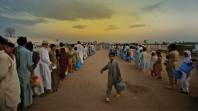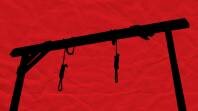Umar* a young student was killed in May last year leaving behind a trail of mental scars for the mourning family.
Riding on his motorbike on Lahore’s main Canal Road, Umar had been speeding when something made him hit his brakes. Instead of a smooth halt, the bike stopped suddenly with Umar flying across to the side island receiving severe head injuries.
He died on the way to hospital.
Statistics show that Umar was only one of the several hundreds who paid with their lives in Lahore due to various road accidents. The year 2012 proved to be lethal in terms of road accidents with the Rescue services counting about 1,500 fatalities. Add to this the at least 30,000 others who were injured and you get a fair idea about how unruly — and morbid — the scene is.
Compare this to the fatalities in bomb blasts in the whole of Punjab: 104.
“I have seen sole breadwinners lose their lives in accidents just because of there is poor implementation of the traffic rules by the traffic police,” says a Rescue official.
Citizens, too, have noted that the level of attention that the traffic police used to have at one time is definitely not the same anymore.
Ahmed Khan, a businessman who travels within other cities, concurs that Lahore is far worse than any other city.
“These wardens let expensive cars whiz by the red light while others are stopped and harassed at trivialities,” complains a college student. “Rules should apply to everyone equally.”
Interestingly, a number of traffic wardens are unaware of the traffic rules as they have not received basic training so far.
Arshad Dogar, a crime reporter, explains that a lot of problems have occurred because of this.
“In Lahore alone, about 300 traffic wardens have been performing duties for the past one year without basic training, something which is mandatory under police rules,” he says.
“It is due to the laxity of officers. These wardens of sub-inspector ranks were appointed in August 2011 and they joined their duties in December without getting any initial training, which lasts a minimum nine months at one of the Certified Training Centres.”
In spite of their lack of training, the wardens are sent at major roads and sensitive areas with almost zero knowledge of their responsibilities and powers. They are deputed at the routes of VVIPs even though they have little training for handling emergencies.
Massive traffic jams are observed daily on the major city roads as the wardens are not trained to maintain the flow of traffic. The untrained wardens disappear from their duties and leave the commuters at the mercy of the traffic. Complaints of misbehavior have also come to the fore.
One traffic warden confesses his lack of basic knowledge himself.
“I try my best but I cannot change the fact that I am slightly confused when it comes to some basic duties and powers,” he says, on condition of anonymity. “There have been times when I have applied wrong violation codes on challan forms and had to face the wrath of commuters. And then many of us are still unclear when it comes to report writing.”
“If our seniors are even slightly concerned about our careers and performing better they should have us trained at the Motorway Police Training Centre; just two batches of selected wardens for Ring Road Force were trained,” adds another warden.
According to official data provided by the Rescue service, a startling number of 36,293 road accidents were reported in Lahore only till December 21, 2012.
Controlling the flow of heavy is a continuing failure with slow movement on city roads during the day and especially during busy evenings and rush hour. Slow moving vehicles, including donkey-carts loaded with iron bars, trudge along without safety measures while slow moving vehicles such as bicycles are sailing along in the fast lanes.
Cars swerve suddenly to overtake each other, and some dash by in full speed posing the risk of injuring a pedestrian or cyclist, if not crashing into something. Horrendous accidents have been witnessed on weekend nights.
On weekend nights, one of the main Defence roads approaching from the Cavalry Ground is the chosen rendezvous for car racing. Boys are seen converging on a Petro-mart nearby who later compete against each other up and down the smooth straight road. However, traffic police is nowhere to be seen as they leave their posts by about 11pm.
While the traffic wardens bear the brunt of criticism by citizens and others, it would not be completely correct to place the entire blame on them.
If wardens are letting violations go by unnoticed, it is ultimately the citizens themselves who break these rules and cause the accidents.
One traffic warden who is posted on an important main road says he has tried many times to stop the traffic rule breakers but he has almost given up.
“For some reason, drivers here lack the kind of road sense that is needed and drive recklessly,” says Ajmal*.
“People blame the police only, forgetting how they themselves drive recklessly, betraying a lack of traffic rules, lane discipline and adherence to signals. These, and speed thrills, result in severe accidents, which mostly occur at traffic signals.”
On a positive note, the Traffic Police has made an effort to try and make people understand that wearing helmets is critical while riding a motorbike. The death of Umar, the young student on the Canal Road, may perhaps, have been averted if he had been wearing a helmet, which would have been shock proof, and avoided head injuries.
Scattered all over the city are signboards on a new and sometimes gruesome campaign telling bikers to wear helmets before they meet their end in horrible accidents.
A Rs200 fine has been fixed for the riders (including pillion riders) for not wearing a helmet. However, though motorbike drivers are stopped for this reason, pillion riders which occasionally mean entire families, are let go.
To make matters worse, the construction of almost all major roads during the year without recourse to safety measures for road users has also resulted in accidents.
The construction of the Canal Road, Metro Bus System and Allama Iqbal Road claimed a number of lives. Extremely poor diversion plans around under-construction roads and the absence of road signs sent drivers into blind alleys, resulting in fatal accidents.
Another major factor responsible for many accidents in Lahore towards the end of the year is fog. For instance, by mid-December last year, the visibility at Ravi Bridge and the Islamabad Motorway was only about 50 metres. Even fog lights sometimes do not help.
The National Highway Authority and Motorway Police issued instructions for motorists to use fog-lights and hazard lights and to reduce speed while driving but despite the warning a number of accidents did occur.
In a superficial comparison between the traffic of Karachi and Lahore, Dr Arif Hasan, a Karachi-based urban planner who is also associated with the Urban Resource Centre, says the main difference between the two cities is that Karachi’s roads are much better planned.
“In terms of road quality, Karachi may fall behind Lahore, though now a lot of roads have been dug up and left undone in Lahore, too,” he says.
“However, when it comes to a better network of roads and alternative routes, Karachi is far ahead. Lahore has not adapted to its growing population in a similar way and has been continuously using the same main roads for all purposes.”
Dr Kamil Khan Mumtaz, a renowned architect and urban planner, says ultimately the issue is caused by too many vehicles.
“Lahore has become a megalopolis with all urban activities including education, commerce, entertainment, etc taking place at one place in the city. Eventually, traffic flow converges and more traffic automatically means more accidents.
While the method of circulation has to be pinpointed and dealt with, in Pakistan this means motorcars. With outward horizontal expansion, there are cars circulating all across the city increasing the amount of unmanageable traffic flow.
“The rest of the world has understood the negative consequences of this and have worked on increasing buses and pedestrianism. But we are far behind,” he says.
“All Lahore needed was buses but the Chief Minister’s Metro Bus plan is an attempt to replace this need by building flyovers and underpasses. The cost of all these structures is a whole lot more than bringing in buses and decreasing motor traffic.”
Dr Mumtaz suggests that in order to reduce cross city traffic flow, and thereby have less congestion and traffic accidents, Lahore must be decentralized by dividing it into towns, with each town being about 1 or 2kms across, with schools, economic opportunities, entertainment facilities etc all in one place so that people would not have to travel so much.
“While Lahore is in serious need of public transport, the government comes up with the most expensive solutions to remedy these and the problem stays the same,” he says.
(*The names have been changed to protect the identity of the victims)
The writer is a freelance journalist. She is an IVLP alumni and currently doing her Masters in Criminology.
























